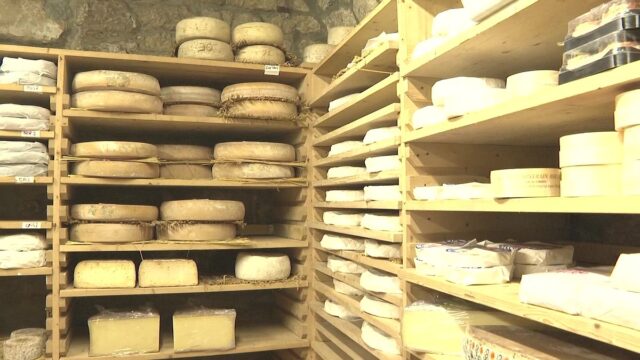From rich blue Roquefort to creamy Camembert, the average Frenchman buys 12.5 kilos of cheese a year. And with 1,200 types available, the French are certainly spoiled for choice.
Cheese is a food almost synonymous with France, but while it remains a French staple, the way it is eaten is starting to change.
Fromagerie Quatrehomme is an emblematic parisian store which opened its doors in the 1950s and has been selling cheese for more than 70 years.
Markets around 300 different types of cheesefrom the Avesnes meatball from conical shapes, made with cow’s milk in northern France, to a variety of goat cheeses from the Loire Valley, the Alps and other regions.
“I think that traditionally a cheese plate is eaten after the main course and before dessert. “This is the traditional way to have a cheese plate in France,” he says. Nathalie Quatrehomme, owner of Fromagerie Quatrehomme. “But I think this traditional way is evolving. Now you can eat the whole cheese plate with meatyou can eat cheese in an appetizer and not after the main course. You can have cheese for breakfast. We really changed the way we eat cheese and that’s good,” she explains.
Cheese is big business
In 2022, France exported cheese worth an estimated value of 3.5 billion euros and imported around 2.5 billion euros, according to the OCE.
According to the CNIEL, the dairy sector as a whole also represents almost 300,000 jobs there.
And at Fromagerie Quatrehomme there is a lot of work, since it is one of the few cheese factories in Paris that has its own cellar.
Staff working underground tend to the cheese wheels, removing unwanted bacteria and caring for the rinds that must be removed regularly.
Some they brush to eliminate bacteria unwished.
“We keep them in warehouses in different areas, here we have different types of warehouses, it depends on their maturity. Some cheeses will need more humidityothers will need a drier atmosphere, others will need to be held back to be truly “candied” or creamy, others will need to be washed. That’s why we really adapt our care to the different needs of the cheese,” says Quatrehomme.
Quatrehomme currently operates five stores in Paris, but this cheese factory located on the border between the 6th and 7th arrondissement is the original and has a loyal clientele.
And they have noticed that Parisians know what they want: French cheeses.
There is also cheese beyond France
Cheese production is widespread throughout Europe with its national specialties country by country.
In addition to being part of the European food industry, it is inserted in the productive structure. Has border problems like any other product. It is inserted in Parties and celebrations. Provokes commercial battles over brands and types. The economic problems end up being heard; in fact, In May, farmers’ protests reached the institutions of the European Union in Brussels: they asked for a law on the prices of dairy products that would guarantee them more equitable incomes. They also suffer impact of climate change.
The case of Spain
Spain produces at least 200 cheeses with a total of 26 designations of origin. The industry evolves. The maturing master José Luis Martín at the head of the cheese specialty store criedbelieves that in Spain a kind of “cheese revolution” is brewing“: “Spain is a great unknown in the world of cheese, especially outside because it is true that everyone knows Manchego.* In fact, we have 28 protected designations of origin and about 200 varieties of cheese. In the last ten years, new cheesemakers have joined, people who come from other specialties or other professions, who liked the subject, such as wine, and then they have really been the ones who have created the new products, the ones who have innovated. and now we can find soft cheeses, goat and sheep, something that was unthinkable before.
The birthplace of fondue, in addition to manufacturing, matters
Small but mighty cheesemaking nation, Switzerland is the birthplace of fondue, the rich, melting winter treat that will warm your heart as you reach for your Lactaid. She is also known around the world for Swiss cheese, or Emmentalthe hard cheese full of holes that grates and melts like a dream.
But despite producing 32 different varieties, Switzerland is also a large cheese importer foreign. It ranks third in the world in trade value per capita, only behind the Netherlands and Belgium.
Additional sources • Enrique Barrueco (Voice-over)







